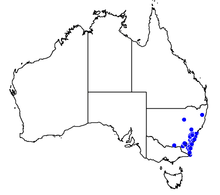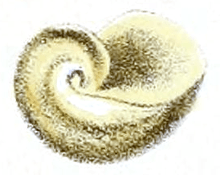Helicarion mastersi
Helicarion mastersi is a species of air-breathing land snail, also referred to as a semi-slug because of its small shell. It is a terrestrial pulmonate gastropod mollusc in the family Helicarionidae.
| Helicarion mastersi | |
|---|---|
 | |
| Helicarion mastersi, about 1 inch (2.5 cm) long, crawling on a wet track at Pigeon House Mountain, Australia | |
| Scientific classification | |
| Kingdom: | |
| Phylum: | |
| Class: | |
| (unranked): | clade Heterobranchia
clade Euthyneura clade Panpulmonata clade Eupulmonata clade Stylommatophora clade Sigmurethra clade limacoid clade |
| Superfamily: | |
| Family: | |
| Subfamily: | Helicarioninae |
| Genus: | |
| Species: | H. mastersi |
| Binomial name | |
| Helicarion mastersi | |
| Synonyms | |
|
Vitrina mastersi J. C. Cox, 1868 | |
The specific name mastersi is in honor of the Australian malacologist George Masters (1837-1912),[2] who collected the type specimen.[1]
Subspecies
Subspecies include:

Distribution
This species is found in New South Wales, Australia.[4]
The type locality is Kiama, New South Wales, Australia.[1]
Description
Helicarion mastersi was originally described (under the name Vitrina mastersi) by James Charles Cox in 1868. Cox's original text (the type description) reads as follows:[1]
Shell depressed, very thin, smooth, transparent, extremely shining, very finely curvately striated, with a few faint spiral lines, bright golden yellow with occasionally a greenish tinge; spire very slightly prominent, apex central, suture impressed, narrowly margined; whorls 3, slightly convex, last rather depressed, rounded at the periphery, and rather convex beneath on outer half; aperture (mollusc) diagonal, lunately ovate; peristome simple, right margin slightly dilated above and in front, left rather straightly continuous with the columella, which is strongly arcuate above, the left margin and base membranous and flattened.
Diameter, greatest 0.55; least 0.38; height 0.17; aperture 0.35 long; 0.27 broad, of an inch.
Habitat. Kiama, N. S. W. − Masters.
A delicate bright golden-yellow hyaline shell, allied to V. Strangei, but easily distinguished by being much more depressed, and having half of the base membranous. The animal of this shell is whitish, and not grey as in V. Strangei.
 Drawing of apical view. |
 Drawing of umbilical view. |
Ecology
This semislug lives in closed Eucalyptus forests. It is primarily an arboreal species, but it can also be found in leaf litter.[4]
References
This article incorporates public domain text from the reference[1]
- Cox, J. C. (1868). A Monograph of Australian Land Shells. Sydney: William Maddock. p. 86, plate XIV, figure 12, 12a. Retrieved 2014-10-03.
- Coan E. V., Kabat A. R. & Petit R. E. (15 February 2011). 2,400 years of malacology, 8th ed. Archived 2012-11-11 at the Wayback Machine, 936 pp. + 42 pp. [Annex of Collations]. American Malacological Society
- Iredale, T. (1941). Guide to the land shells of New South Wales Pt III. Australian Naturalist. 11. pp. 1–8.
- "Species: Helicarion mastersi (Cox, 1868)". Australian Faunal Directory. 5 February 2014. Retrieved 2014-10-03.
External links
| Wikimedia Commons has media related to Helicarion mastersi. |
- "Species Helicarion mastersi (Cox, 1868)". Australian Faunal Directory, accessed 18 September 2011.